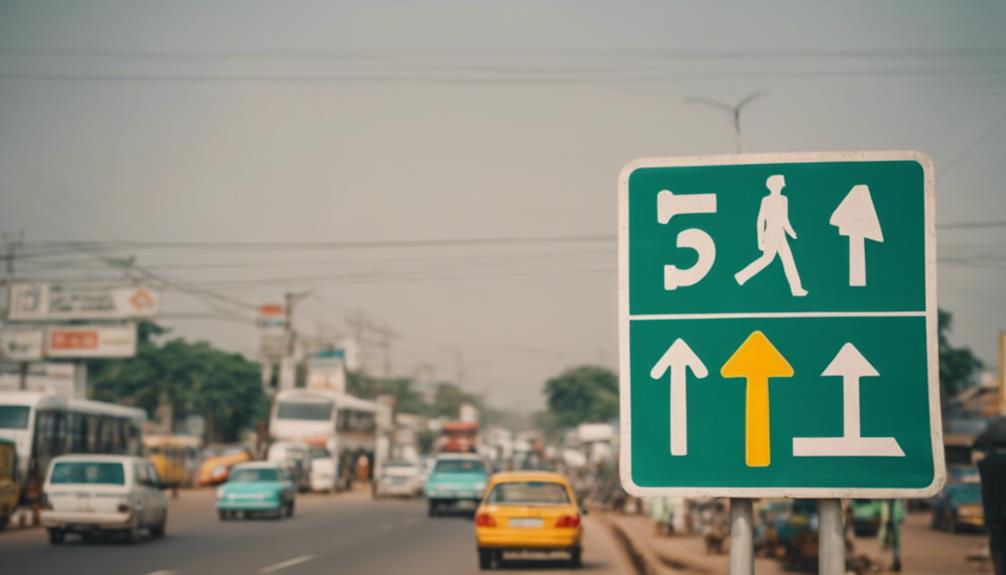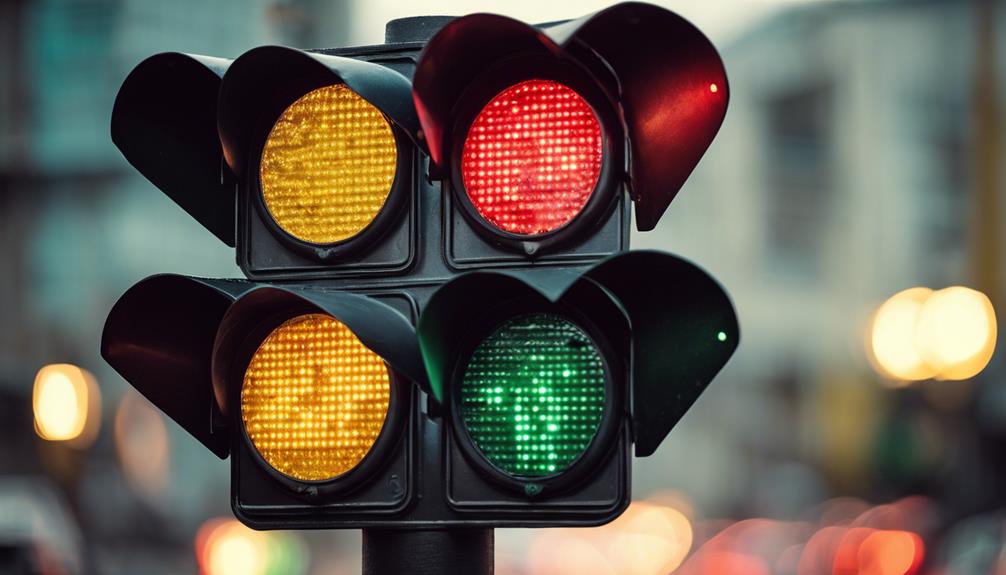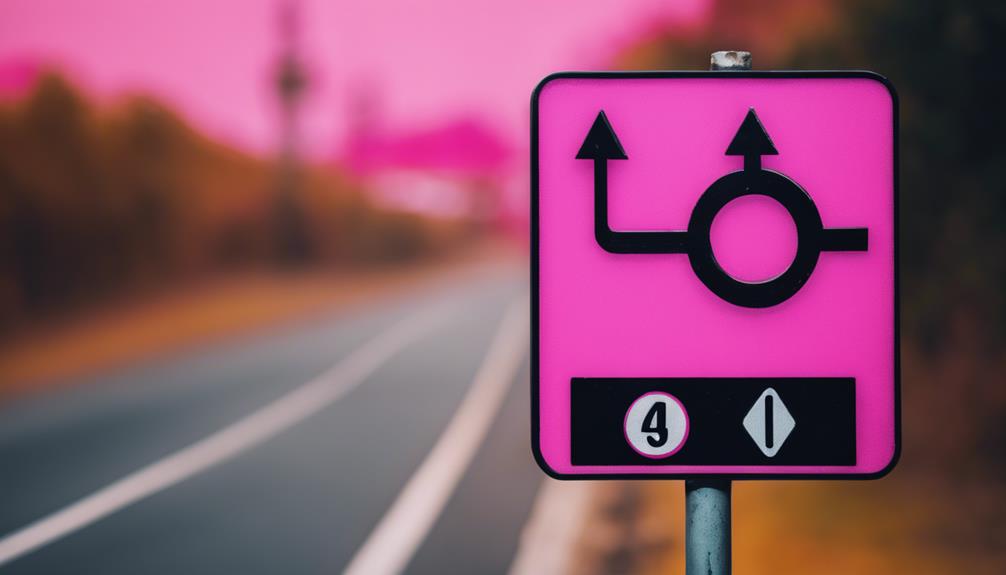Grasping essential road signs in **Nigeria** is crucial for **safe driving**. Knowing signs with **blue backgrounds** for mandatory instructions and **yellow backgrounds** for prohibitive guidance keeps traffic flowing smoothly and ensures law compliance. Symbols like **speed limits** and **directional arrows** share important info. Recognizing warning signs with **triangular shapes** and **bold colors** makes them more visible and safe. Understanding road markings helps prevent accidents and ensures smooth travel. Traffic signals matter too: **red means stop**, **yellow means prepare to stop**, and **green means go if safe**. Knowing **zebra crossings** and **yellow boundary lines** helps maintain order on the roads. Click here to dive deeper into the essentials of road signs.
Key Takeaways
- Mandatory signs in Nigeria have blue backgrounds and white inscriptions for essential instructions.
- Prohibitive signs feature yellow or white backgrounds, black inscriptions, and red borders for clear warnings.
- Understanding informative symbols like speed limits and directional arrows is crucial for safe driving practices.
- Warning road signs in Nigeria are triangular with bold colors like yellow and black for immediate attention.
- Deciphering road markings, like yellow lines indicating opposite directions, is vital for safe and efficient travel in Nigeria.
Understanding Regulatory Road Signs
When driving in Nigeria, we must understand the importance of regulatory road signs to guarantee our safety on the roads. These road signs play a critical role in providing essential instructions and guidelines for safe driving practices.
In Nigeria, regulatory road signs encompass a variety of categories, including mandatory, prohibitive, and regulatory information. Mandatory signs, distinguished by blue backgrounds and white inscriptions, indicate actions that drivers must take, such as adhering to speed limits or specific lane usage. On the other hand, prohibitive signs, with yellow or white backgrounds, black inscriptions, and red borders, communicate actions that aren't permitted, like no entry or no parking zones.
Understanding and obeying these regulatory road signs is crucial for ensuring a safe and orderly flow of traffic, minimizing the risk of accidents, and maintaining compliance with traffic laws. By familiarizing ourselves with these signs and their meanings, we contribute to creating a safer driving environment for all road users in Nigeria.
Interpreting Informative Symbols

Understanding the symbols on road signs is crucial for grasping their meanings.
These symbols convey vital information to assist us in driving safely.
Let's explore the significance behind these symbols and how to interpret them accurately to navigate our roads with confidence.
Symbol Meanings Explained
Understanding the meanings of informative symbols on road signs in Nigeria is essential for safe driving practices. These symbols are vital for providing guidance and important information to drivers, helping them navigate safely on the roads. By interpreting road markings accurately, drivers can adhere to speed limits, follow directions, and be aware of potential hazards. To aid in comprehension, below is a table explaining some common informative symbols found on Nigerian road signs:
| Symbol | Meaning |
|---|---|
| Speed Limit Sign | Indicates the maximum speed allowed |
| Directional Arrows | Shows the permitted direction of travel |
| Route Signs | Guides drivers towards specific routes |
| Pedestrian Crossing | Warns of pedestrian crossing areas |
Visual Communication Tips
Let's now shift our focus to exploring practical tips for interpreting informative symbols visually on Nigerian road signs. Road safety is essential when it comes to understanding these symbols.
Rectangular shapes containing speed limit signs, directional arrows, route signs, and pedestrian crossing signs are common on Nigerian roads. These symbols provide vital information such as speed restrictions, directions, and the locations of facilities like hospitals and gas stations.
Universally recognized colors and shapes are used to guarantee clear communication to drivers. Mastering the interpretation of these informative symbols is necessary for safe and informed driving experiences on Nigerian roads.
Understanding Road Signs
Understanding Nigerian roads safely involves mastering the interpretation of informative symbols found on road signs. Nigerian traffic signs play an important role in providing guidance to drivers. These symbols convey essential information such as speed limits, directional arrows, pedestrian crossings, and route signs. By understanding these symbols, drivers can make informed decisions while traveling the roads.
It's essential to interpret these signs accurately to anticipate road conditions and adhere to traffic regulations. Familiarity with Nigerian traffic signs enhances road safety by helping drivers travel effectively and promoting efficient traffic flow. As such, mastering the interpretation of informative symbols on road signs is key to ensuring a safe and smooth driving experience on Nigerian roads.
Recognizing Warning Road Signs

Keeping an eye out for warning road signs while driving in Nigeria is essential for road safety. These signs indicate potential hazards ahead and require immediate attention from drivers. Here are some key points to remember when recognizing warning road signs:
- Triangular Shape: Warning road signs in Nigeria are typically triangular in shape, making them easily distinguishable from other types of signs on the road.
- Bold Colors: These signs use bold colors like yellow and black to guarantee visibility, especially during adverse weather conditions or low light situations.
- Universal Symbols: Warning signs feature universally recognized symbols such as sharp curves, slippery roads, pedestrian crossings, animal crossings, and steep inclines, conveying a clear message to all drivers.
Understanding and obeying these warning road signs is essential for preventing accidents and ensuring the safety of all road users. By being vigilant and responsive to these signs, drivers can contribute to a safer road environment for everyone.
Deciphering Road Markings' Meanings

As we navigate the roads in Nigeria, interpreting the meanings behind various road markings becomes essential for ensuring safe and efficient travel. Yellow lines on Nigerian roads serve as indicators of opposite directions and are important for separating lanes. Double yellow lines are particularly notable as they signify areas where parking or stopping is strictly prohibited. Understanding the importance of white lines, whether solid or broken, is vital as they provide guidance on lane changes and restrictions. Solid white lines, for instance, denote no-overtaking zones, emphasizing the significance of following lane rules to prevent accidents. To help grasp these concepts better, let's explore a table outlining the meanings of different road markings:
| Road Marking | Meaning |
|---|---|
| Yellow Lines | Opposite directions, lane separations |
| Double Yellow Lines | No parking or stopping |
| White Lines | Lane changes, restrictions |
| Solid White Lines | No-overtaking zones |
Mastering the interpretations of yellow and white lines is fundamental for safe driving practices, contributing significantly to accident prevention and overall road safety in Nigeria.
Navigating Traffic Signal Lights

As drivers, we must understand the importance of traffic light colors to navigate intersections safely. Following signal light rules is essential for preventing accidents and maintaining order on the roads.
Reacting promptly and appropriately to changing lights guarantees smooth traffic flow and avoids congestion.
Understanding Traffic Light Colors
Driving through traffic signal lights involves understanding the importance of different colors to guarantee safe and efficient travel at intersections. When encountering traffic lights, remember:
- Red Light: Stop completely to prevent accidents.
- Yellow Light: Prepare to stop or proceed with caution.
- Green Light: Proceed if the intersection is clear and safe.
Adherence to these traffic light colors is essential for smooth traffic flow and avoiding collisions.
Understanding the meanings of each color helps drivers navigate intersections safely and efficiently. Remember, safety is paramount when approaching traffic signals to guarantee a seamless and secure journey for all road users.
Following Signal Light Rules
When approaching traffic signal lights, we must follow the designated rules for safe movement and efficient traffic flow on the road. Traffic signal lights in Nigeria follow the standard red (stop), yellow (prepare to stop/caution), and green (go) sequence.
Adherence to these signal lights is essential for coordinating traffic movements at intersections and ensuring smooth traffic flow. It's important to pay attention to the white stop lines, which indicate where vehicles should come to a stop at traffic signals.
Understanding and obeying signal light rules help prevent collisions, enhance road safety, and reduce the risk of accidents. Effectively managing traffic signal lights is essential for safe driving practices on the road.
Reacting to Changing Lights
Getting through changing traffic lights demands alertness and prompt decision-making to guarantee safe and efficient movement on the road. When faced with changing lights, it's vital to understand the signs they convey:
- Red Light: Signifies a complete stop
- Yellow Light: Serves as a warning to prepare to stop or proceed cautiously
- Green Light: Indicates permission to go if the road is clear
Obeying these signals is important for ensuring safety and preventing accidents at intersections. Remember, red means stop, yellow means caution, and green means go.
Comprehending Red and Green Lights

With a clear understanding of red and green lights, motorists can navigate intersections safely and efficiently. When approaching a traffic light, a red signal means a mandatory stop. This requires coming to a complete halt before the designated stop line. On the other hand, a green light indicates permission to proceed. It is important to wait for the green light before moving forward to guarantee a smooth flow of traffic. Understanding and obeying these signals are essential for preventing accidents and maintaining order on the roads. Here is a table summarizing the meanings of red and green lights:
| Traffic Light | Meaning |
|---|---|
| Red | Stop |
| Green | Go |
Identifying Blue Special Lanes

Blue special lanes on Nigerian roads serve specific purposes and are marked with distinctive blue lines to indicate their designated use for certain types of vehicles. Understanding these blue special lanes is essential for safe and efficient driving.
Here are key points to help you identify and navigate these lanes:
- Bus Lanes: Blue lines on the road denote lanes reserved for buses, allowing them to move swiftly and smoothly through traffic.
- High-Occupancy Vehicle Lanes: Some blue special lanes are designated for vehicles carrying multiple passengers, encouraging carpooling and reducing congestion.
- Emergency Lanes: Blue lines may also indicate lanes reserved for emergency vehicles, ensuring quick access to areas requiring urgent assistance.
Adhering to Zebra Crossings

Zebra crossings play an essential role in guaranteeing pedestrian safety and traffic flow on Nigerian roads. Identified by white horizontal stripes, these crossings give pedestrians the right-of-way, promoting safe road usage. As drivers, it's our responsibility to yield to pedestrians waiting to cross at zebra crossings. This simple act not only guarantees pedestrian safety but also fosters peaceful coexistence between vehicles and pedestrians on our roads. Understanding and respecting zebra crossings is fundamental in maintaining order and safety in Nigeria.
When approaching a zebra crossing, be vigilant for pedestrians who may be waiting to cross. Slow down and come to a complete stop if necessary to allow them to safely traverse the road. Remember, pedestrians have the right-of-way at zebra crossings, and it's our duty as drivers to respect this rule. By adhering to zebra crossings, we contribute to a safer and more organized road environment for everyone.
Respecting Yellow Boundary Lines

Showing respect for yellow boundary lines on Nigerian roads is important for ensuring safety and efficient traffic flow. When driving, it's vital to understand the significance of these markings to uphold road regulations and prevent accidents. Here are key points to remember:
- Exercise Caution: Yellow boundary lines indicate areas where drivers should proceed with care, signaling potential hazards or changes in road conditions.
- No Parking or Stopping: Double yellow lines signify that stopping or parking is prohibited along those sections of the road, helping to maintain smooth traffic flow and prevent obstructions.
- Avoid Violations: Violating yellow boundary lines can lead to fines or penalties as outlined in the Nigeria Highway Code, emphasizing the importance of adhering to these markings for road safety.
Respecting yellow boundary lines not only promotes safe driving practices but also contributes to the overall management of traffic on Nigerian roads. By staying attentive to these markings, drivers can play their part in creating a safer and more organized driving environment for all road users.
Frequently Asked Questions
What Are the Regulatory Road Signs in Nigeria?
Regulatory road signs in Nigeria are essential for safe driving. These signs provide important instructions to drivers and help enforce traffic rules. Understanding and following these signs is critical for road safety, preventing accidents, and ensuring orderly traffic flow.
Compliance with regulatory road signs is necessary to avoid fines and maintain a safe driving environment. By paying attention to these signs, we can all contribute to safer roads and a better driving experience for everyone.
What Are the Mandatory Road Signs?
Mandatory road signs in Nigeria are essential for safe driving. These signs have a blue background with white inscriptions, providing important instructions to drivers. Examples include speed limits, no parking zones, and direction indicators. Ignoring these signs can lead to violations and endanger road safety.
Understanding and following mandatory road signs is important for responsible driving in Nigeria. It's essential to pay attention to these signs to guarantee a safe journey on the road.
What Does the Yellow Line on the Road Mean in Nigeria?
Yellow lines on Nigerian roads help drivers understand boundaries and rules. Double yellow lines mean no parking or stopping to keep traffic flowing smoothly.
Understanding these lines is crucial for safe driving and avoiding fines. They guide us on the road, helping us make good choices.
Following yellow line rules is key to keeping Nigerian roads safe and organized.
Why Do We Need Road Signs in Nigeria?
Road signs in Nigeria are essential for safe driving. They provide important instructions, warnings, and guidance to help us navigate the roads effectively. Understanding and obeying these signs is crucial for making informed decisions and preventing accidents.
What are the important road signs in Nigeria for safe driving?
In Nigeria, important road signs for safe driving include speed limit signs, pedestrian crossing signs, and warning signs for curves and intersections. Understanding the meaning of no outlet sign is also crucial, as it indicates a dead-end road with no exit. These signs help drivers navigate safely and efficiently.
Conclusion
Now that we've learned about essential road signs in Nigeria for safe driving, remember to always be vigilant on the road.
Do you know what to do when you see a red light at an intersection? It's important to follow the rules and signals to guarantee the safety of yourself and others.
Keep these guidelines in mind every time you hit the road to make sure you arrive at your destination safely.










